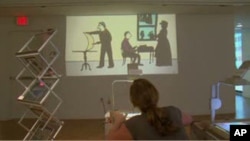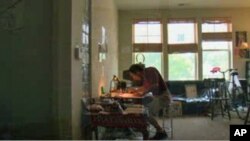Even in a recession, communities across the United States are discovering that money invested in the arts can provide a return.
That's the case in Rosslyn, Virginia, just a few miles from the nation's capital. Live music draws at least a few people out of their air-conditioned offices on an exceptionally hot day.
The free lunchtime concerts are funded by the Rosslyn Business Improvement District (BID). Its members are property owners that rent out space in the high-rise office buildings here.
“It is really important to tenants coming into a commercial office area to have amenities that their workers are going to gravitate to,” says Cecilia Cassidy, executive director of BID.
Artisphere, another amenity for workers in Rosslyn, opened last October. The BID provided $1.2 million to transform what was once the Newseum into an art space that has a little bit of everything.
“We have the visual arts, performing arts, spoken word, dance," says Jose Ortiz, executive director of Artisphere. "The audience varies because we have such a great range of programming.”
And art in unexpected places. Some works invite people to do more than just look. There are also workshops where participants create their own art. Many of the offerings are free.
Putting money into Artisphere was a good investment for Rosslyn property owners, and not only to satisfy workers, according to Jason Schupbach of the National Endowment for the Arts.
“Companies want to go where the people are and the arts are something that tie people to place," says Schupbach. "They actually have been shown to be great economic development drivers.”
Hyattsville, Maryland is banking on that. The Washington suburb was blighted for years, but it's beginning to show signs of life, especially in the area known as the Arts District.
What was once about 50 hectares of empty parking lot is now being developed, despite the economic downturn. New townhouses and retail spaces are being built along with apartments designed for artists.
"They have space for musicians and they have space for people who want to draw and paint downstairs, dancers who do performing arts," says Carl Tucker, a Hyattsville resident who is an artist.
“It was pretty barren before this particular building and other condos in the area were built," says Candis Jones, a recent drama graduate of the Tisch School of the Arts in New York. "I am sure with time there will be more amenities and theater spaces hopefully."
A performing arts space is already in the works. The oldest building in Hyattsville is being transformed into a theater. Seven dollars of new investment comes from every dollar publicly invested in the arts, according to Stuart Eisenberg, executive director of the Hyattsville Community Development Corporation, a nonprofit dedicated to the city's revival. But there's an even greater benefit.
“Not only does it do good for the economy and get pretty, shiny new buildings, but in the long run it transforms peoples’ reality," says Eisenberg. "And that is how you develop a community from stagnant or blighted into something that is an example and a leader for investment.”
And, as the community attracts more development, Eisenberg says there will always be affordable housing for artists because they are the heart of the community.
















